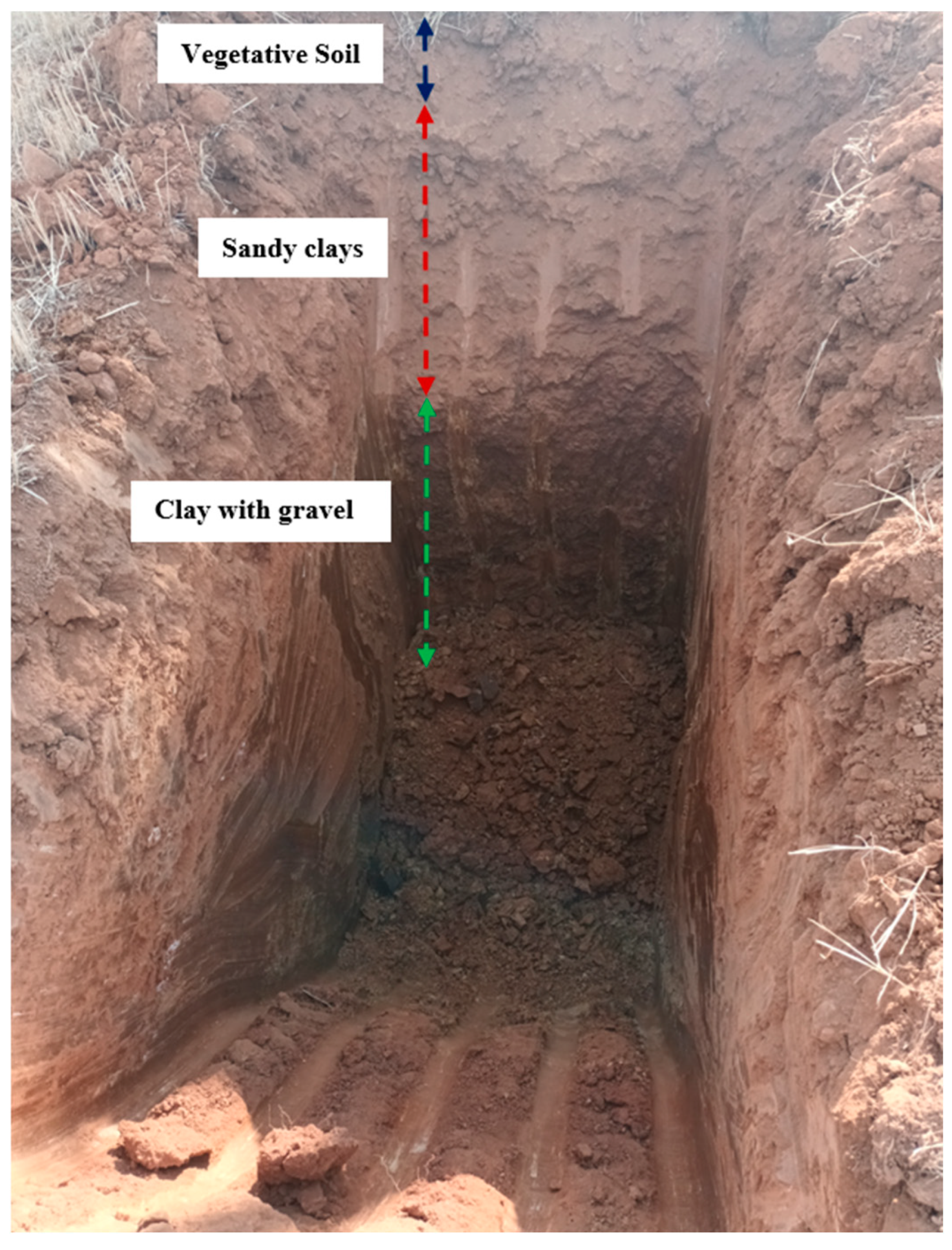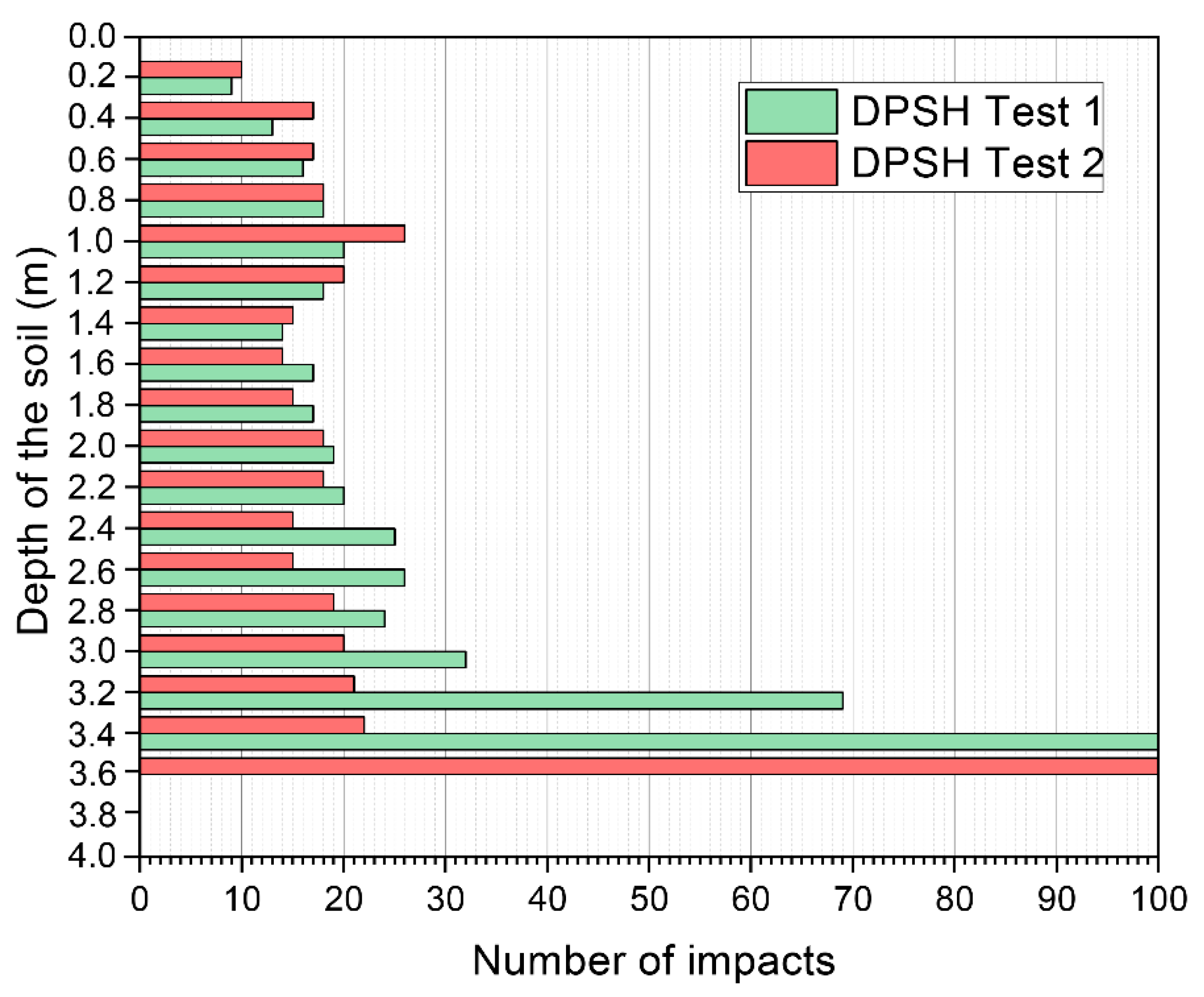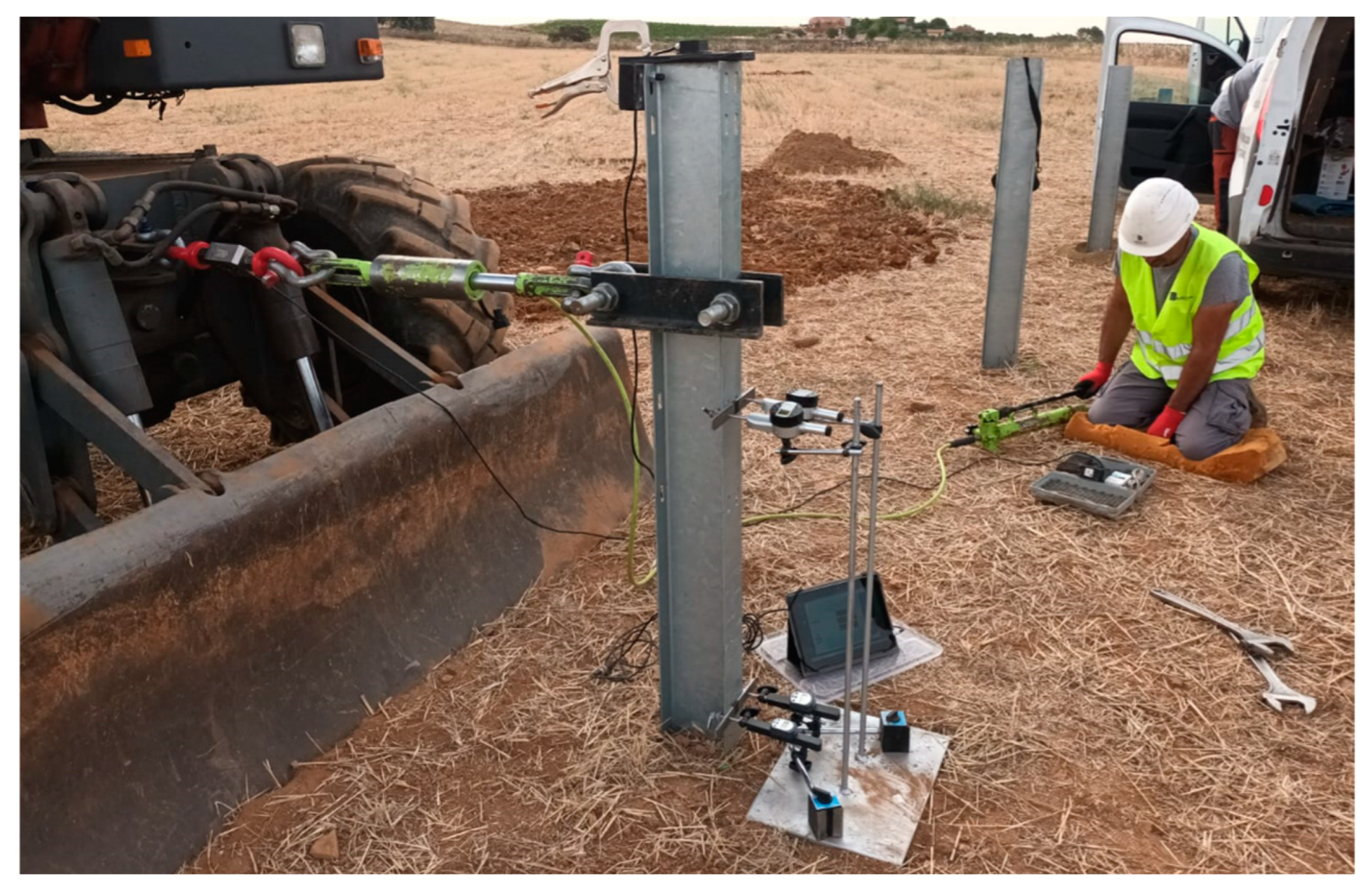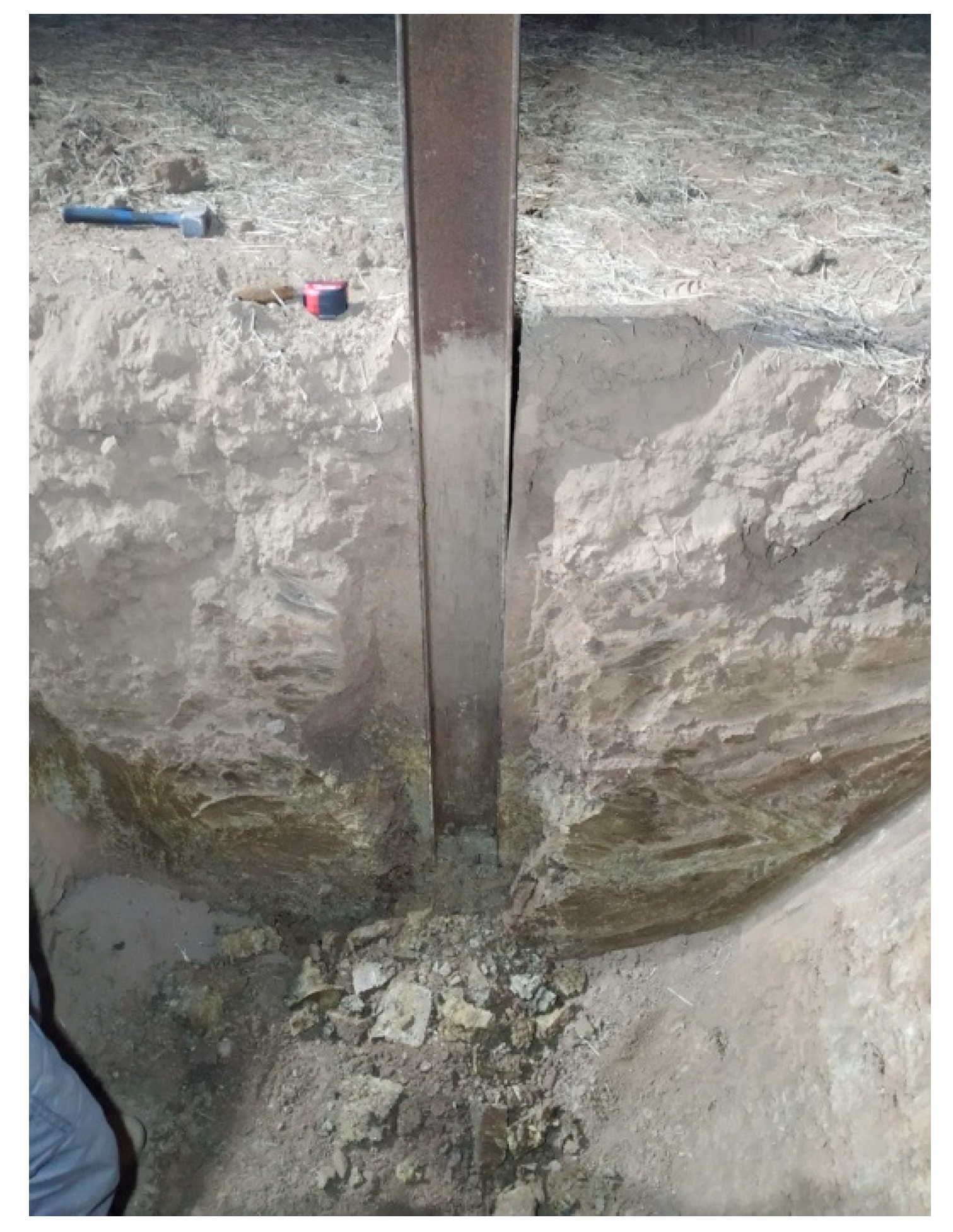Fatigue Behavior of H-Section Piles under Lateral Loads in Cohesive Soil
Abstract
:1. Introduction
2. Methodological Approach
2.1. Steel Pile Description, Properties and Preliminary Testing
2.2. Soil Characterization and Testing
2.2.1. Granulometric Analysis
2.2.2. Atterberg Limits
2.2.3. Direct Shear Strength
2.2.4. Geotechnical Strata Identification
2.2.5. Consistency and Compaction
2.2.6. Soil Characterization and Depth Determination for Experimentation
2.2.7. Horizontal Subgrade Modulus Experimental Calculation
2.2.8. Load Application and Measurement
3. Experimental Campaign
3.1. Monotonic Lateral Load Tests
3.2. Lateral Load Fatigue Tests
3.3. Pull-Out Pile Tests
4. Results and Discussions
4.1. Experimental Determination of Subgrade Reaction
4.2. Fatigue Behavior of Laterally Loaded Piles
4.3. Residual Strength and Pull-Out Capacity after Lateral Loading
5. Concluding Remarks and Significance
- The elastic-plastic deflection of the soil reaches its maximum value during the first loading cycle due to soil compaction. Nonetheless, after a few additional cycles (approximately 10 cycles under the studied conditions), the elastic-plastic deflection per cycle remains constant in all cases examined.
- The permanent or residual deflection of the soil shows a steady increase after the initial compaction phase. This suggests that the soil does not experience fatigue from that point onward and that its lateral load stiffness remains constant for the same cyclically applied load, contrary to what is indicated in other studies on large-diameter piles. Nonetheless, despite the absence of soil fatigue, stability may be compromised due to the accumulated permanent deflection that occurs with each cycle, which can destabilize the system due to the effects of large deformations over the long term.
- The horizontal soil subgrade reaction initially increases with the applied load, enhancing the lateral resistance of the pile through soil cohesion. However, there is an optimal cohesion load beyond which soil degradation and eventual collapse occur as the applied load continues to increase.
- In static monotonic tests, the soil-pile behavior differs depending on whether the applied load is below or above the soil’s optimal cohesion load. Below the optimal load, an initial improvement in soil-pile cohesion is observed; above it, progressive degradation occurs.
- The compaction effects on the surface layers of the soil result in permanent deflection and a loss of pile-soil contact, leading to a consequent decrease in the piles’ tensile capacity. No significant differences were observed between the fatigue tests, indicating that the damage primarily occurs during the initial loading cycles that induce compaction of the surface soil layers.
- From the results of this study, it is evident that the horizontal soil subgrade reaction remains unaffected by repetitive cycles of the same load intensity. However, there is a gradual accumulation of permanent deflection, which could potentially lead to cumulative tilting over time. Therefore, it may be necessary to implement interventions on the structures to correct the alignment of the piles and restore them to their original position.
Author Contributions
Funding
Data Availability Statement
Acknowledgments
Conflicts of Interest
Nomenclature
| A | Pile cross-section |
| b | Width of the pile’s contact surface with soil |
| c | Width of the top flange of the cross-section |
| e | Distance of the horizontal load from the cross-section’s center of gravity |
| E0 | Soil’s elastic modulus |
| Es | Soil’s secant deformation modulus |
| Ep | Steel pile’s elastic modulus |
| G | Shear modulus of the steel pile |
| Ip | Maximum moment of inertia of the steel pile |
| It | Torsional constant of the steel pile |
| Iw | Warping constant of the steel pile |
| Iy | Moment of inertia about the y-axis |
| Iz | Moment of inertia about the z-axis |
| kh | Horizontal modulus of subgrade reaction |
| L | Length of the pile |
| Lde | Length of the pile with zero lateral displacement from the soil surface |
| Le | Embedded length of the pile in the soil |
| Lu | Height of horizontal load application from to soil surface |
| Mt | Torsional moment |
| p | Soil reaction force |
| RH | Horizontal load at the pile head |
| t | Thickness of the web of the cross-section |
| δh | Horizontal or lateral displacement at the pile head |
| δs | Horizontal or lateral displacement at the soil surface |
| ω | Torsional susceptibility index |
References
- Ahangar-Asr, A.; Javadi, A.A.; Johari, A.; Chen, Y. Lateral Load Bearing Capacity Modelling of Piles in Cohesive Soils in Undrained Conditions: An Intelligent Evolutionary Approach. Appl. Soft Comput. 2014, 24, 822–828. [Google Scholar] [CrossRef]
- Chen, Z.; Shuai, S.; Pu, S.; Zhang, L.; Rao, J. Study on the Ultimate Flexural Bearing Capacityof Micro Anti-Slide Piles. Tumu Yu Huanjing Gongcheng Xuebao/J. Civ. Environ. Eng. 2019, 41, 59–66. [Google Scholar] [CrossRef]
- Shakir, R.R.; Zhu, J. Behavior of Compacted Clay-Concrete Interface. Front. Archit. Civ. Eng. China 2009, 3, 85–92. [Google Scholar] [CrossRef]
- Duque, J.; Ochmański, M.; Mašín, D.; Hong, Y.; Wang, L. On the Behavior of Monopiles Subjected to Multiple Episodes of Cyclic Loading and Reconsolidation in Cohesive Soils. Comput. Geotech. 2021, 134, 104049. [Google Scholar] [CrossRef]
- Fuentes, W.; Mašín, D.; Duque, J. Constitutive Model for Monotonic and Cyclic Loading on Anisotropic Clays. Geotechnique 2020, 71, 657–673. [Google Scholar] [CrossRef]
- Zormpa, T.E.; Comodromos, E.M. Numerical Evaluation of Pile Response Under Combined Lateral and Axial Loading. Geotech. Geol. Eng. 2018, 36, 793–811. [Google Scholar] [CrossRef]
- Hazzar, L.; Karray, M.; Bouassida, M.; Hussien, M.N. Ultimate Lateral Resistance of Piles in Cohesive Soil. DFI J.-J. Deep Found. Inst. 2013, 7, 59–68. [Google Scholar] [CrossRef]
- Heller, L.W. Discussion of “Lateral Resistance of Piles in Cohesive Soils. ” J. Soil Mech. Found. Div. 1964, 90, 211–212. [Google Scholar] [CrossRef]
- Kahribt, M.A.; Abbas, J.M. Lateral Response of a Single Pile under Combined Axial and Lateral Cyclic Loading in Sandy Soil. Civ. Eng. J. 2018, 4, 1996. [Google Scholar] [CrossRef]
- Abadie, C.N. Cyclic Lateral Loading of Monopile Foundations in Cohesionless Soils. Ph.D. Thesis, University of Oxford, Oxford, UK, 2015. [Google Scholar]
- Peng, J.; Clarke, B.G.; Rouainia, M. Increasing the Resistance of Piles Subject to Cyclic Lateral Loading. J. Geotech. Geoenviron. Eng. 2011, 137, 977–982. [Google Scholar] [CrossRef]
- Abadie, C.N.; Byrne, B.W.; Houlsby, G.T. Rigid Pile Response to Cyclic Lateral Loading: Laboratory Tests. Geotechnique 2019, 69, 863–876. [Google Scholar] [CrossRef]
- Uncuoǧlu, E.; Laman, M. Numerical Modelling of Short Pile Behaviour Subjected to Lateral Load. Eur. J. Environ. Civ. Eng. 2012, 16, 204–235. [Google Scholar] [CrossRef]
- Vahabkashi, P.; Rahai, A.; Amirshahkarami, A. Lateral Behavior of Piles with Different Cross Sectional Shapes under Lateral Cyclic Loads in Granular Layered Soils. Int. J. Civ. Eng. 2014, 12, 112–120. [Google Scholar]
- Standard Guidelines for the Design and Installation of Pile; American Society of Civil Engineers: Reston, VA, USA, 1997.
- Suthar, D.B.; Chore, H.S.; Dode, P.A. Comparative Analysis of High Rise Building Subjected to Lateral Loads and Its Behavior. In Advances in Structural Engineering; Matsagar, V., Ed.; Springer: New Delhi, India, 2015; pp. 613–625. [Google Scholar]
- Lai, V.Q.; Banyong, R.; Keawsawasvong, S. Stability of Limiting Pressure behind Soil Gaps in Contiguous Pile Walls in Anisotropic Clays. Eng. Fail. Anal. 2022, 134, 106049. [Google Scholar] [CrossRef]
- Chiou, J.S.; Chen, C.H.; Chen, Y.C. Deducing Pile Responses and Soil Reactions from Inclinometer Data of a Lateral Load Test. Soils Found. 2008, 48, 609–620. [Google Scholar] [CrossRef]
- Lu, Y.; Wang, Z.; Yin, Z.; Wu, G.; Liang, B. Experimental and Numerical Studies on Local Scour around Closely Spaced Circular Piles under the Action of Steady Current. J. Mar. Sci. Eng. 2022, 10, 1569. [Google Scholar] [CrossRef]
- Su, X.; Li, Z.; Wang, Q.; Li, J.; Xie, X.; Mao, X.; Ren, Z.; Liu, J. Comparison and Optimization of Bearing Capacity of Three Kinds of Photovoltaic Support Piles in Desert Sand and Gravel Areas. Buildings 2024, 14, 2559. [Google Scholar] [CrossRef]
- Abdelaziz, A.Y.; El Naggar, M.H.; Ouda, M. Determination of Depth-of-Fixity Point for Laterally Loaded Vertical Offshore Piles: A New Approach. Ocean Eng. 2021, 232, 109113. [Google Scholar] [CrossRef]
- Cheng, X.; Ibraim, E.; Liu, H.; Pisanò, F.; Diambra, A. Large Diameter Laterally Loaded Piles in Sand: Numerical Evaluation of Soil Stress Paths and Relevance of Laboratory Soil Element Testing. Comput. Geotech. 2023, 154, 105139. [Google Scholar] [CrossRef]
- Pérez, J.A.; Reyes-Rodríguez, A.M.; Sánchez-González, E.; Ríos, J.D. Experimental and Numerical Flexural–Torsional Performance of Thin-Walled Open-Ended Steel Vertical Pile Foundations Subjected to Lateral Loads. Buildings 2023, 13, 1738. [Google Scholar] [CrossRef]
- Zhao, X.; Liao, X.; Hu, Z.; Li, X.; Nie, Y.; Liu, J.; Xu, Y. Seismic Fragility Analysis of Steel Pipe Pile Wharves with Random Pitting Corrosion. Buildings 2023, 13, 2619. [Google Scholar] [CrossRef]
- Li, W.; Li, X.; Wang, T.; Yin, Q.; Zhu, M. The Simplified Method of Head Stiffness Considering Semi-Rigid Behaviors of Deep Foundations in OWT Systems. Buildings 2024, 14, 1803. [Google Scholar] [CrossRef]
- Wang, M.; Wang, M.; Cheng, X.; Lu, Q.; Lu, J. A New p–y Curve for Laterally Loaded Large-Diameter Monopiles in Soft Clays. Sustainability 2022, 14, 5102. [Google Scholar] [CrossRef]
- Tra, H.T.; Huynh, Q.T.; Keawsawasvong, S. Estimating the Ultimate Load Bearing Capacity Implementing Extrapolation Method of Load-Settlement Relationship and 3D-Finite Element Analysis. Transp. Infrastruct. Geotechnol. 2024, 11, 2764–2789. [Google Scholar] [CrossRef]
- Li, B.; Wang, Y.; Qi, W.; Wang, S.; Gao, F. Lateral Bearing Capacity of a Hybrid Monopile: Combined Effects of Wing Configuration and Local Scour. J. Mar. Sci. Eng. 2022, 10, 1799. [Google Scholar] [CrossRef]
- Chen, Y.-J.; Lee, Y.-H. Evaluation of Lateral Interpretation Criteria for Drilled Shaft Capacity. J. Geotech. Geoenviron. Eng. 2010, 136, 1124–1136. [Google Scholar] [CrossRef]
- Bauer, J.; Reul, O. Lateral Pressure on Pile Foundations in Cohesive Soils Due to Horizontal Soil Movements. Acta Geotech. 2024, 19, 6375–6390. [Google Scholar] [CrossRef]
- Zhang, L.; Ahmari, S. Nonlinear Analysis of Laterally Loaded Rigid Piles in Cohesive Soil. Int. J. Numer. Anal. Methods Geomech. 2013, 37, 201–220. [Google Scholar] [CrossRef]
- Luo, R.; Hu, M.; Yang, M.; Li, W.; Wang, A. Static Design for Laterally Loaded Rigid Monopiles in Cohesive Soil. J. Mar. Sci. Eng. 2023, 11, 817. [Google Scholar] [CrossRef]
- Aghayarzadeh, M.; Khabbaz, H.; Fatahi, B.; Terzaghi, S. Interpretation of Dynamic Pile Load Testing for Open-Ended Tubular Piles Using Finite-Element Method. Int. J. Geomech. 2020, 20, 04019169. [Google Scholar] [CrossRef]
- Liyanapathirana, D.S.; Deeks, A.J.; Randolph, M.F. Behaviour of Thin-Walled Open-Ended Piles during Driving. In Computational Mechanics–New Frontiers for the New Millennium; Elsevier: Amsterdam, The Netherlands, 2001; pp. 393–398. [Google Scholar] [CrossRef]
- Qin, W.; Cai, S.; Dai, G.; Wang, D.; Chang, K. Soil Resistance during Driving of Offshore Large-Diameter Open-Ended Thin-Wall Pipe Piles Driven into Clay by Impact Hammers. Comput. Geotech. 2023, 153, 105085. [Google Scholar] [CrossRef]
- Zhu, N.; Cui, L.; Liu, J.; Wang, M.; Zhao, H.; Jia, N. Discrete Element Simulation on the Behavior of Open-Ended Pipe Pile under Cyclic Lateral Loading. Soil Dyn. Earthq. Eng. 2021, 144, 106646. [Google Scholar] [CrossRef]
- Kido, R.; Suezawa, R.; Sawamura, Y.; Kimura, M. Experimental Investigation of Bearing Mechanism of Closed- and Open-Ended Piles Supported by Thin Bearing Layer Using X-ray Micro CT. Soils Found. 2022, 62, 101179. [Google Scholar] [CrossRef]
- ASTM D3966/D3966M-22; Standard Test Methods for Deep Foundation Elements Under Static Lateral Load. ASTM: West Conshohocken, PA, USA, 2022.
- Ministère de l’Equipement Du Logement et Des Transports. Fascicule 62, Titre V: Règles Techniques de Conception et de Calcul Des Fondations Des Ouvrages de Génie Civil; Ministère de l’Equipement Du Logement et Des Transports: Paris, France, 1993.
- ASTM A6/A6M; Standard Specification for General Requirements for Rolled Structural Steel Bars, Plates, Shapes, and Sheet Piling. ASTM: West Conshohocken, PA, USA, 2001.
- Terzaghi, K. Evaluation of Coefficients of Subgrade Reaction. Géotechnique 1955, 5, 297–326. [Google Scholar] [CrossRef]
- UNE-EN ISO 22476-2:2005; Geotechnical Investigation and Testing—Field Testing—Part 2: Dynamic Probing. ISO: Geneva, Switzerland, 2005.
- Terzaghi, K.P.R.B.M.G. Soil Mechanics in Engineering Practice; Wiley: Hoboken, NJ, USA, 1996. [Google Scholar]
- Lambe, W.T.; Whitman, R.V. Soil Mechanics; John Wiley & Sons: Hoboken, NJ, USA, 1969. [Google Scholar]
- Goh, S.G.; Rahardjo, H.; Leong, E.C. Shear Strength of Unsaturated Soils under Multiple Drying-Wetting Cycles. J. Geotech. Geoenviron. Eng. 2014, 140, 06013001. [Google Scholar] [CrossRef]
- Lu, N.L.W.J. Unsaturated Soil Mechanics; Wiley: Hoboken, NJ, USA, 2004. [Google Scholar]
- UNE-EN ISO 17892; Geotechnical Investigation and Testing—Laboratory Testing of Soil. ISO: Geneva, Switzerland, 2019.
- Witt, K.J. Grundbau-Taschenbuch; Ernst & Sohn: Hoboken, NJ, USA, 2017. [Google Scholar]
- Bowles, J.E. Foundation Analysis and Design; McGraw-Hill: New York, NY, USA, 1997. [Google Scholar]
- Broms, B.B. Lateral Resistance of Piles in Cohesive Soils. J. Soil Mech. Found. Div. 1964, 90, 27–63. [Google Scholar] [CrossRef]
- Basack, S. A Boundary Element Analysis of Soil-Pile Interaction under Lateral Cyclic Loading in Soft Cohesive Soil. Asian J. Civ. Eng. Build. Hous. 2008, 9, 379–390. [Google Scholar]
- Matlock, H. Correlation for Design of Laterally Loaded Piles in Soft Clay. In Proceedings of the Offshore Technology Conference, Houston, TX, USA, 22–24 April 1970. [Google Scholar]
- Reese, L.C.; Van Impe, W.F. Single Piles and Pile Groups under Lateral Loading; CRC Press: Boca Raton, FL, USA, 2010; ISBN 9780429109706. [Google Scholar]
- Prakash, S.S.H.D. Pile Foundations in Engineering Practice; CBS: New York, NY, USA, 2013. [Google Scholar]
- Vesić, A.B. Bending of Beams Resting on Isotropic Elastic Solid. J. Eng. Mech. Div. 1961, 87, 35–53. [Google Scholar] [CrossRef]
- Phoon, K.-K.; Tang, C. Characterisation of Geotechnical Model Uncertainty. Georisk Assess. Manag. Risk Eng. Syst. Geohazards 2019, 13, 101–130. [Google Scholar] [CrossRef]
- Phoon, K.-K. Reliability-Based Design in Geotechnical Engineering: Computations and Applications; CRC Press: Boca Raton, FL, USA, 2008. [Google Scholar]










| Profile | h (mm) | tw (mm) | b (mm) | tf (mm) | A (cm2) | Iy (cm4) | Iz (cm4) | It (cm4) |
|---|---|---|---|---|---|---|---|---|
| W6 × 15 | 152.15 | 5.84 | 152.15 | 6.60 | 28.58 | 1211.23 | 387.93 | 4.20 |
| Sample | Prospecting | Depth (m) | USCS Classification | LL (%) | PL (%) | PI (%) |
|---|---|---|---|---|---|---|
| M-1 | C-1 | 1.0 | CL | 47.8 | 30.0 | 17.8 |
| M-3 | C-2 | 0.8 | CL | 36.8 | 24.3 | 12.5 |
| Sample | Prospecting | Depth (m) | USCS Classification | LL (%) | PL (%) | PI (%) |
|---|---|---|---|---|---|---|
| M-2 | C-1 | 2.0 | GC | 43.1 | 28.2 | 14.9 |
| M-4 | C-2 | 1.7 | GM-GC | 28.1 | 22.7 | 5.4 |
Disclaimer/Publisher’s Note: The statements, opinions and data contained in all publications are solely those of the individual author(s) and contributor(s) and not of MDPI and/or the editor(s). MDPI and/or the editor(s) disclaim responsibility for any injury to people or property resulting from any ideas, methods, instructions or products referred to in the content. |
© 2024 by the authors. Licensee MDPI, Basel, Switzerland. This article is an open access article distributed under the terms and conditions of the Creative Commons Attribution (CC BY) license (https://creativecommons.org/licenses/by/4.0/).
Share and Cite
Pérez, J.A.; Ponce-Torres, A.; Ríos, J.D.; Sánchez-González, E. Fatigue Behavior of H-Section Piles under Lateral Loads in Cohesive Soil. Buildings 2024, 14, 3228. https://doi.org/10.3390/buildings14103228
Pérez JA, Ponce-Torres A, Ríos JD, Sánchez-González E. Fatigue Behavior of H-Section Piles under Lateral Loads in Cohesive Soil. Buildings. 2024; 14(10):3228. https://doi.org/10.3390/buildings14103228
Chicago/Turabian StylePérez, José A., Alberto Ponce-Torres, José D. Ríos, and Estíbaliz Sánchez-González. 2024. "Fatigue Behavior of H-Section Piles under Lateral Loads in Cohesive Soil" Buildings 14, no. 10: 3228. https://doi.org/10.3390/buildings14103228






